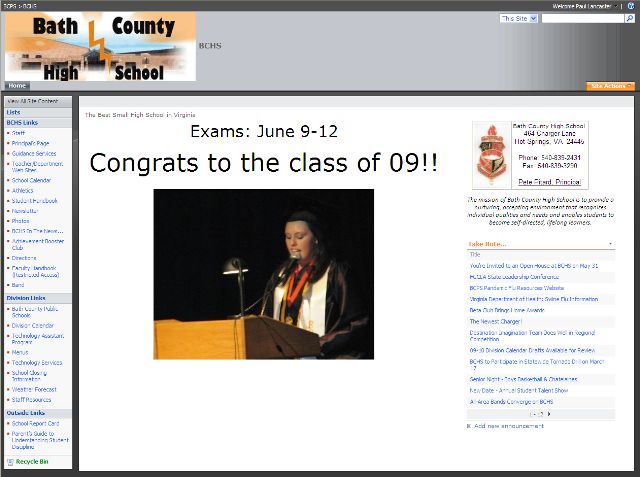2.2.1.2 Divisionwide Computer Use
All major departments and functions of the school division are supported with computer technology. Communication, collaboration and data storage systems in place for division staff are now mission-critical:
-
Food Service management software and customized reporting software has been in place since 2003, and menus are posted online each month. The food service director utilizes online tools to manage reimbursements & place orders, and uses reporting tools developed and maintained by technology staff.
-
Transportation department vehicle diagnostic hardware and software are in regular use, and division vehicle/trip scheduling is accomplished through a secure online calendar tool.
-
Maintenance Department HVAC monitoring and control hardware and software help keep division buildings comfortable and keep administrators informed of potential problems, and an online maintenance work request system should be online soon.
-
Administrative and instructional support systems have been established to handle a number of key functions across the school division, including
-
Central Office Payroll & accounts payable – AccuFund and spreadsheets developed by business office and technology staff
-
School Accounts Payable – Activity Accounting
-
Budgeting – Excel spreadsheets
-
Student Information System Database (Demographics, Attendance, Scheduling, Grade Reporting, Teacher Gradebook, Parent Access) – PowerSchool
-
Special education student records system – IEP Online
-
Child Plus – Head Start student records system
-
School library management systems – Follett Destiny
-
Emergency Notification System – School Messenger
-
Report Cards for K-3 – “Fillable” Word documents developed and maintained by technology staff
-
Divisionwide email has been provided for staff with local server resources since 1996, and
-
Browser-based resources for information and document management have been in place since 2005.

Technological support for classroom instruction is critical for students to receive a quality education. Instructional staff need proper tools and training to provide rich educational experiences for students, and students need regular access to technology to develop 21st Century problem solving skills. The Virginia Computer/Technology Standards of Learning provide a backdrop for thinking about technology planning, though the division’s instructional focus is appropriately on how learning is facilitated by technology, rather than on specific technology skills.
Bath County Public Schools has provided computer technology to assist instruction since 1980, but the most exciting, pervasive and influential technology integration project is the Tablet Computer Technology Integration Program now in its fifth year. Wireless tablet computers and wireless LCD projectors help teachers to utilize technology during direct instruction in a much more natural fashion than ever before. Lightweight convertible computers can function as traditional notebook computers, but with a flip and twist of the display become mobile teaching devices that literally replace the chalkboard in many classrooms. Using a stylus, teachers are able to annotate directly on the computer screen text and drawings that help presentations come alive for students. The wireless computers and LCD projectors cut out the cord that previously restricted teacher movement during presentations. Teachers can hand off the tablet PC for a student to respond to a question "on the board," without getting out of his/her desk.



Teachers are invited each year to participate in technology integration activities. Those that show initial interest and willingness to learn and adapt are encouraged to sign up for the tablet PC technology integration initiative. This 45-hour professional development program has done much for classroom technology use by providing teachers with the tools and knowledge to perform the latest technology integration strategies with their students. Technology integration is more than using a computer in the classroom—it is also using peripheral tools like digital cameras, Flip Video camcorders, digital voice recorders, document cameras, and others. Web 2.0 tools need to be used on a regular basis to provide a rich online learning environment--both at school and from home: document sharing, dynamic lists, discussion groups, wikis, and blogs all have their place in the 21st Century classroom. The point is for teachers and their students to become more active, thorough and involved presenters & learners. Indeed, our best teachers understand that they provide our students the greatest service when they are able to ignite a passion for learning rather than opening a receptacle for remembered facts.
Browser-based information sharing across the school division has mushroomed since spring 2006 when Windows SharePoint Services was first installed. The economical, easy to use, but powerful database system immediately proved itself useful with the development of a divisionwide fluid calendar system that combines central office, school, athletic department and other calendars into one centralized calendar. The division calendar is then ‘filtered’ to only show events for a particular building, program or even sport. The multi-user nature of SharePoint Services is much of the power behind the calendar option, but is also the strength in other areas as well. An issue with web development through the years has been that adding content was restricted to a skilled individual or small group with ‘webmaster’ privileges. Because SharePoint Services utilizes an easy to use, consistent user interface across all applications, staff members and students have differentiated posting and design rights to sites and lists as appropriate to their need. Types of SharePoint Services sites available for development include:
-
General web sites with text, hyperlinks, photos, imbedded html & javascript
-
Customized lists of all sorts, with unlimited content and media types
-
Calendars
-
Announcements
-
Document Libraries
-
Picture Libraries
-
Form Libraries
-
Surveys
-
Discussion groups
-
Wikis
-
Blogs
-
Task Lists
-
Contact Lists

SharePoint Services in Bath County Public Schools has grown to now comprise our entire browser-based resources: internal/restricted and public internet:
-
Comprehensive school and department web sites with many of the above webparts, managed by various school staff
-
Divisionwide resources including extensive document libraries such as division forms and school board policy
-
The number of classroom websites has tripled in the three years, with teachers using SharePoint services to post homework assignments, announcements, class photos, recommended web links, and student work.
-
A perpetual divisionwide goal is to increase the quantity and quality of communications with local patrons. Our broad web presence does much to assist with this effort, as parents, staff, students and community members are able to review some of the good things going on in our school division, helping to focus on the contributions of so many individuals for the good of our local youth. On the division home page alone, there are nearly 150 short “In The News” articles highlighting division achievements and initiatives. Many more good news items are found in school, department and classroom websites.
Electronic student records systems have been in use in Bath County Schools for over twenty years. The division is currently transitioning to the newest Pearson PowerSchool program, with greatly increased functionality and ease of use. The most remarkable new features include:
-
Grade Reporting processes capable of spanning K-12 grade levels
-
Browser-based delivery system requires less data moving within the network, and enables 24/7 secure access from any internet enabled computer—staff, parents and students will be able to access appropriate types of student data from home
-
The browser-based system is housed in one centralized server with triple virtual machines configured for maximum performance capability, while reducing hardware, maintenance and energy costs.
Standards of Learning assessments (grades 3-12) are administered online at all three schools, utilizing both fixed and mobile labs to accommodate both large and small groups of students. The program was initiated at Bath County High School in 2003 with just one subject area, gradually phased in throughout the high school, introduced to the elementary schools, and eventually implemented for third grade students. The program has been well-received by both students and staff. Student test results are known far in advance of the paper equivalent—and often within just a few minutes after the test is administered. E-SOL testing is a high demand test of system resources: workstations, network electronics and bandwidth, but testing has gone relatively smoothly since its inception.
The local school board has had in place an Acceptable Use Policy since 1996 to help guide appropriate computer/internet use of students and staff. Students are only allowed to access school technology if an Acceptable Use Policy form is signed by both the student and a parent/guardian and on file at the school. All division staff that use computers are also required to sign the Acceptable Use Policy.
Return to Home Page